

重返山水
Back To Qinglv
2022.11.5 – 2022.12.12
艺术家:董大为
Artist: DONG DAWEI
地址:北京市朝阳区酒仙桥路2号798艺术区中二街D06 Tong Gallery+Projects
Venue: D06, Middle 2nd St., 798 Art Zone, No. 2 Jiuxianqiao Rd, BJ
2004年,董大为开始临摹敦煌壁画。最初这纯粹是因为工作需要,日复一日,对照壁画照片,比对着画册勾勒佛像,再按原作填上颜色。你无法称那时的董大为为一个艺术家——这种枯燥的劳作并非创作,这种重复的单调里并无自由。
然而某种意义上,这次驱动艺术家董大为创作的,正是18年前那些非艺术的、机械的描摹。在描摹中,他第一次注意到了早期的敦煌壁画。彼时,印度佛教的“梵相”技艺不断传入,正深刻地改变着中国壁画制作的方法。而阿富汗、伊朗等中亚地区的青金石和绿松石,也经丝绸之路进入中国,开始在敦煌的岩壁上铺展成青绿颜色——这正是中国青绿山水画的前身。
青绿的颜色吸引着董大为。与唐之二李、宋之王希孟,或元之赵孟頫笔下的青绿不同,这些敦煌岩壁上的青绿显得那么随性:一方面,它们仍受制于线描师画下的轮廓线条,但有时这些颜色并不会完全涂满,有时覆盖在线上,有时甚至会任性地越出线外。而到了盛唐时期,颜色与线条的主次关系变得更为微妙。王玉东在评价彼时的石窟壁画时这样写到:“一些处于从属地位的敦煌布色者,开始拒绝遵从画师白画所设定的规矩,不再让他的色彩受控,大胆地给予 ‘雄辩’ 的颜色以独立的生命……我们隐约感觉到,色彩已经在喧宾夺主。” 因而,这些青绿不仅成为树木,成为山峦,还成为了岩石,成为了脚下的大地——在被认为枯燥的涂色中,这些无名的布色者们有一种自由。
在这几年间,董大为不断返回历史,找寻这些主流叙事之外的自由。他将它们称之为“理想绘画”。在2020年的个展《风景画像》中,董大为回看东西方风景画诞生的历程,阐释了达到“理想”的第一个解法:破除“主体—背景”的双重结构。两年之后的今天,他试图再次打破绘画中另一对隐秘的权力关系:颜色-线条。在绘画发展的历程中,线条构成了主体,构成了主题,代表了“非黑即白的真理”。而相比表意准确的线条而言,颜色对于人眼来说具有诱惑性,甚至欺骗性。颜色永远是附属的,它们是画面填充物,装饰品。然而,对董大为而言,绘画发展的历程,却是一段颜色挣脱二元束缚,成为颜色自身的历程
—— 毕竟,人永远无法用线条描绘天空。
In 2004, Dong Dawei began to copy Dunhuang Mural. At first, it was purely because of the need of work. Day after day, he compared the mural photos, sketched the Buddha statue in the picture album, and then filled in the color according to the original work. You can’t call Dong Dawei an artist at that time – this boring work is not creation, and there is no freedom in this repetitive monotony.
However, in a sense, what drives the artist Dong Dawei to create this time is exactly those non artistic and mechanical descriptions 18 years ago. In copying, he first noticed the early Dunhuang murals. At that time, the “Brahman phase” skill of Indian Buddhism was constantly introduced, which was profoundly changing the method of making Chinese murals. The lapis lazuli and turquoise from Central Asia, such as Afghanistan and Iran, also entered China via the Silk Road and began to spread in green on the rock walls of Dunhuang – the precursor of Chinese green landscape painting.
The green color attracts Dong Dawei. Unlike the blue-green paintings by Li Zhier of the Tang Dynasty, Ximeng of the Song Dynasty, or Zhao Mengfu of the Yuan Dynasty, the blue-and-green paintings on the Dunhuang cliffs are quite casual: on the one hand, they are still subject to the contour lines drawn by the line painters, but sometimes these colors are not completely painted, sometimes they are covered on the line, and sometimes they even wilfully go beyond the line. In the prosperous Tang Dynasty, the primary and secondary relationship between color and line became more subtle. Wang Yudong wrote in his evaluation of the grotto murals at that time: “Some color setters in Dunhuang who were in a subordinate position began to refuse to follow the rules set by the painter’s white paintings, no longer let his colors be controlled, and boldly gave an independent life to the ‘eloquent’ colors… We vaguely felt that colors were already dominating.” As a result, these greens not only become trees and mountains, but also become rocks and the earth under their feet. In the color setting that is considered boring, these nameless color setters have a freedom.
During these years, Dong Dawei kept returning to history to find freedom beyond the mainstream narrative. He called them “ideal paintings”. In his solo exhibition Landscape Portrait in 2020, Dong Dawei looked back at the birth process of eastern and western landscape painting and explained the first solution to reach the “ideal”: breaking the dual structure of “subject background”. Two years later today, he tried to break another pair of hidden power relations in painting: Color-Line. In the course of the development of painting, lines constitute the main body, constitute the theme, and represent the “truth that is black or white”. Compared with the lines with accurate expression, color is attractive to the human eye, even deceptive. The color is always attached, they are the screen filler and decoration. However, for Dong Dawei, the development of painting is a process in which colors break away from the dual bondage and become colors themselves
——After all, people can never depict the sky with lines.















关于艺术家
Artist

董大为 | DONG Dawei
1981年生于大连,现生活工作于北京东五环东六环之间。2011年毕业于法国布尔日国立高等艺术学院,获国家造型表现学位及评审最高嘉奖。2004年毕业于鲁迅美术学院,获学士学位。个展包括:“元素和像素”,飞地艺术空间,深圳,中国(2021);“风景画像”,HDM画廊,北京,中国(2020);“背面”,今格空间,北京,中国(2019);香港巴塞尔艺术展亚洲视野单元/杨画廊,香港,中国(2018);“可见之光”,亚洲当代艺术空间,台北,台湾(2017)等。
Born in Dalian, China. 1981 Lives and works between the East Fifth Ring Road and the East Sixth Ring Road in Beijing. Obtaining DNSEP with congratulations by the jury in ENSA-Bourges (Ecolenationale supérieure d’art de Bourges), France. Obtaining the Bachelor of Arts in LuXun Academy of Fins Arts, China in 2004. Solo Exhibitions: Element And Pixel, Enclave Contemporary, Shenzhen, China (2021). Landscape Portrait, HDM Gallery, Beijing, China (2020). Backside, GinkGo Space,Beijing, China (2019);Insight Asia, Art Basel Hong Kong, Hong Kong, China (2018). Visible Light, A+ Contemporary, Taibei, Taiwan (2017) etc.

Comments (0)